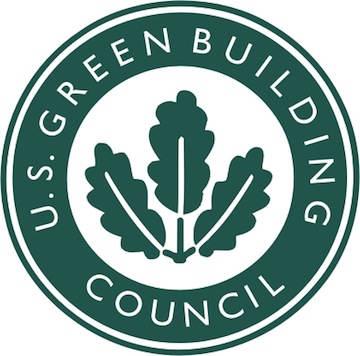The U.S. Green Building Council (USGBC) has released its annual list of the top 10 states for new LEED certifications in 2012, highlighting those regions that are transforming buildings and communities across the country.
The per-capita list is based on 2010 U.S. Census data and includes commercial and institutional buildings certified under LEED, through which approximately 2.2 billion sf has been certified worldwide through 2012.
"Securing a spot on this list is a remarkable achievement for everyone involved in the green building movement in these states," said Rick Fedrizzi, president, CEO and founding chair, USGBC. "From architects and designers to local chapter advocates, their collective efforts have brought sustainable building design and use to the forefront of the national discussion on the environment, and I applaud their efforts to create a healthier present and future for the people of their states."
Once again, the District of Columbia tops the ranking, with 36.97 sf of LEED space certified per resident in 2012.
Meanwhile, Virginia moved into position as the top state, with 3.71 sf certified per resident in 2012, overtaking Colorado, with 2.10 sf certified per person.
Other top states include Massachusetts, which moved up three positions from 2011, with 2.05 sf per person; Illinois, with 1.94 sf; and Maryland, with 1.90 sf of LEED space certified per resident in 2012.
Reflecting the ongoing trend of LEED existing buildings outpacing their newly built counterparts, in 2012 the LEED for Existing Buildings: Operations & Maintenance rating system accounted for 53% of total sf certified in these states, compared to 32% certified under LEED for New Construction.
The full ranking, which includes 10 states plus Washington, D.C., is as follows:
|
Rank |
State |
Projects certified in 2012 |
Square feet of LEED space certified in 2012 |
Per-capita square footage |
|
1 |
District of Columbia |
110 |
22,246,445 |
36.97 |
|
2 |
Virginia |
170 |
29,709,574 |
3.71 |
|
3 |
Colorado |
99 |
10,553,881 |
2.10 |
|
4 |
Massachusetts |
106 |
13,395,597 |
2.05 |
|
5 |
Illinois |
156 |
24,949,997 |
1.94 |
|
6 |
Maryland |
127 |
10,954,324 |
1.90 |
|
7 |
New York |
214 |
34,378,286 |
1.77 |
|
8 |
Washington |
133 |
10,521,177 |
1.56 |
|
9 |
California |
540 |
54,252,993 |
1.46 |
|
10 |
Texas |
224 |
36,017,979 |
1.43 |
|
11 |
Nevada |
29 |
3,741,941 |
1.39 |
"Buildings are a primary focus of our mayor's Sustainable DC initiative," said Keith Anderson, Interim Director, District of Columbia Department of the Environment. "We are indeed thrilled to be leading the nation in per-capita LEED certified space. Our private and public building sectors are boldly leading with the development of high performing green buildings, and we have aligned governmental policies to support such innovation." +
Related Stories
K-12 Schools | Nov 30, 2022
School districts are prioritizing federal funds for air filtration, HVAC upgrades
U.S. school districts are widely planning to use funds from last year’s American Rescue Plan (ARP) to upgrade or improve air filtration and heating/cooling systems, according to a report from the Center for Green Schools at the U.S. Green Building Council. The report, “School Facilities Funding in the Pandemic,” says air filtration and HVAC upgrades are the top facility improvement choice for the 5,004 school districts included in the analysis.
Legislation | Nov 23, 2022
7 ways the Inflation Reduction Act will impact the building sector
HOK’s Anica Landreneau and Stephanie Miller and Smart Surfaces Coalition’s Greg Kats reveal multiple ways the IRA will benefit the built environment.
Green | Nov 13, 2022
USGBC updates LEED v4 to better address greenhouse gas emissions and climate change
The U.S. Green Building Council (USGBC) will update the LEED v4 green building certification program to “more directly address greenhouse gas emissions and climate change” according to a USGBC news release.
Green | Nov 13, 2022
NREL report: Using photovoltaic modules with longer lifetimes is a better option than recycling
A new report from the U.S. National Renewable Energy Laboratory (NREL) says PV module lifetime extensions should be prioritized over closed-loop recycling to reduce demand for new materials.
Green | Nov 13, 2022
Global building emissions reached record levels in 2021
Carbon-dioxide emissions from building construction and operations hit an all-time high in 2021, according to the most recent data compiled by the Global Alliance for Buildings and Construction.
University Buildings | Nov 13, 2022
University of Washington opens mass timber business school building
Founders Hall at the University of Washington Foster School of Business, the first mass timber building at Seattle campus of Univ. of Washington, was recently completed. The 84,800-sf building creates a new hub for community, entrepreneurship, and innovation, according the project’s design architect LMN Architects.
Industry Research | Nov 8, 2022
U.S. metros take the lead in decarbonizing their built environments
A new JLL report evaluates the goals and actions of 18 cities.
Green | Nov 8, 2022
USGBC and IWBI will develop dual certification pathways for LEED and WELL
The U.S. Green Building Council (USGBC) and the International WELL Building Institute (IWBI) will expand their strategic partnership to develop dual certification pathways for LEED and WELL.
Green | Oct 5, 2022
In California, a public power provider’s new headquarters serves as a test case for an innovative microgrid and for reducing greenhouse gas emissions
Sonoma Clean Power (SCP), the public power provider for California’s Sonoma and Mendocino Counties, recently unveiled its new all-electric headquarters.
Green | Oct 3, 2022
California regulators move to ban gas heaters for existing buildings
California regulators voted unanimously recently on a series of measures that include a ban on the sale of natural gas-powered heating and hot water systems beginning in 2030.

















